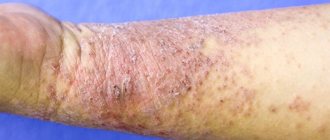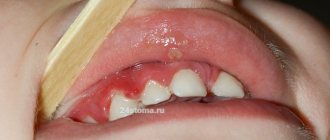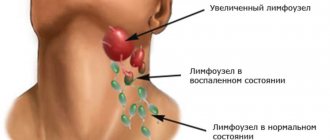December 3, 2020
Contact dermatitis is an inflammation of the skin in an area that has come into contact with an irritating substance or environmental factor. Children under 12 years of age are most susceptible to the disease. The point is the structural features of children's skin and the weakness of its protective mechanisms. The disease manifests itself in any area that has been in contact with the irritant, but more often on the face, arms, neck, and groin area.
If the provoking agent is recognized in time and the child is protected from it, the inflammation is well treated and the symptoms quickly pass. When the cause is difficult to identify or parents do not consult a doctor on time, the course of the disease becomes more severe.
Contact dermatitis occurs:
- simple - local irritation by some factor;
- allergic.
The second option will appear when the child has an increased sensitivity to this substance. The first interaction with it is outwardly unnoticeable, but chemicals are formed in the skin that bind to immune cells - T-lymphocytes. Immune cells remember the stimulus. Upon repeated contact, which can occur after a long time, T-lymphocytes trigger an allergic reaction and cause skin symptoms.
How to recognize allergic contact dermatitis in a child
The contours of the inflammation often coincide with the outlines of the object that caused the irritation. The rash spreads little beyond the area of skin that came into contact with the causative factor. The skin here becomes red and swollen, very itchy, blisters, wounds and crusts appear.
Fungal and bacterial infections easily attach to wounds and suppuration occurs. Babies may experience an increase in general temperature.
Frequent exacerbation in the same places leads to unpleasant outcomes: areas of increased or decreased pigmentation, scars, thickening and roughening of the skin.
If you notice a rash or red spots on your child’s skin, be sure to see a doctor to get tests done to determine the exact cause and begin treatment.
The disease may worsen. To prevent this from happening, you need to find and eliminate the provoking causes.
Causes of tongue itching
In young children, itching of the tongue can be caused by food allergies . You should review the child's menu and exclude those foods that can provoke irritation of the organ. Against the background of an allergy, the tongue may not only itch, but also hurt, tingle and swell, and the stool may acquire a liquid consistency. With allergies, symptoms appear immediately upon contact with the allergen or after a short period of time.
A rash may appear on the cheeks or throughout the body. With obstruction, breathing becomes difficult and swelling occurs. It should be remembered that allergies can be a consequence of problems in the gastrointestinal tract, especially if the temperature rises and diarrhea appears.
Food allergies
Candidiasis is manifested by the presence of a white coating on the mucous membranes of the mouth and tonsils, but the back of the tongue is clean. The child may experience a sour taste and pain when swallowing. Usually the fungus is contained in the baby’s body in a latent form and the catalyst for the disease can be a weakened immune system, injury to the mucous membrane of the mouth or tongue. When the tongue is cleaned, under the coating you can see an inflamed focus of infection of a bright scarlet color.
Candidiasis
The tonsils may also become covered with white dots due to chronic tonsillitis , but in this case the formations are sporadic and the oral cavity is clean. The resulting crusts must be carefully removed with a cotton swab or bandage, as this is nothing more than purulent discharge.
Worm infestation in a baby manifests itself in the mouth area, and not just in the anus area. Itching can be either constant or periodic. The tongue may not only itch, but sometimes there is a burning sensation.
In diseases of the gastrointestinal tract, itching is not accompanied by other visual changes in the oral cavity, except for a white coating along the entire base of the tongue. But the patient may be bothered by pain in the right hypochondrium and itchy skin.
In case of caries, the damaged tooth should be filled immediately, otherwise the location of the disease becomes a favorable environment for harmful bacteria to live.
Infectious diseases of a long course can also provoke the appearance of microbes in the pharynx, penetrating there through the nasal passages.
External causes of the development of allergic dermatitis in children
The disease can be caused by one of the factors or a combination of several.
- Physical - friction or pressure on the skin of fabrics, leather products, high or low temperatures, humidity, electric current, ultraviolet or x-rays.
- Chemical - various acids and alkalis, substances included in creams and hygiene products, medicines, tobacco smoke.
- Biological - sap and pollen of plants, bites and secretions of insects and animals.
Of the plant agents, the most dangerous are the juice of celandine, hogweed, nettle, pollen of meadow and weeds.
In industrial cities in winter, there are widespread cases of contact dermatitis under the eyes and on the hands of children. Three factors are combined here: cold, chemical impurities in the air and touching the skin with wet mittens.
In infants, allergic inflammation can be caused by a combination of high humidity in diapers, fabric friction and the action of inappropriate cream.
A special type of contact dermatitis is phototoxic, when sunscreens degrade in sunlight and cause allergic damage to the epidermis.
The urge to scratch the gums and drooling
Children generally tend to put everything in their mouths, but as teething begins, this need may increase noticeably. If your baby always wants to scratch his gums on something, this is a clear sign that he is teething. Make sure that the child cannot reach dangerous objects that could block his airway, and let the baby chew special teething rings.
Another sign of rapid teething is excessive drooling: in some babies it can be so intense that their clothes become wet through, and skin irritation appears around the mouth and chin. To help keep your baby comfortable and rash-free, gently wipe away any saliva from his face and change wet clothes as needed.
Dermatitis in a child and psychosomatics
Skin health directly depends on a person’s mental well-being. Stress changes hormonal levels and metabolism, causing disruptions in the functioning of the immune system. Therefore, a calm emotional state will prevent exacerbation of the disease and delay the first appearance of symptoms.
When faced with contact dermatitis, analyze the causes and identify the allergen that caused it.
It's not always easy. To be sure of the correct diagnosis, conduct the necessary tests and receive treatment, come for a consultation at our center. In addition to treatment, you will learn how to properly prevent this disease. December 3, 2020
Author of the article: dermatologist Mak Vladimir Fedorovich
Diagnostics
The first doctor you should visit will be your dentist . It should exclude diseases of the mouth, teeth and gums. If the child’s tongue itches due to internal problems, then the pediatrician will help. He will prescribe general urine and blood tests, a biochemical blood test and, depending on the type of disease, prescribe treatment and, if necessary, give a referral to a gastroenterologist.
If the problem is gastrointestinal diseases, then it will be necessary to do a gastroscopy with a urease test and an ultrasound of the abdominal cavity. All these examinations will show which organ needs treatment. In case of an allergic reaction, it is worth visiting an allergist and getting tested for allergens if the causative agent is initially unknown.
Signs of pinworms in children
Maintaining personal hygiene - preventing enterobiasis
If a parent notices such symptoms in their child, this may serve as the appearance of “unwanted guests” in the young body:
- Itching in the anal area. This indicates that the female is already laying eggs. Most often, this symptom intensifies at night, when the body is at rest.
- Mechanical damage to the skin in the buttocks area. It is impossible to stop yourself from scratching the infected area. Babies can scratch their skin until it bleeds. This can cause additional complications in the form of infections and inflammation.
- Disorder of the gastrointestinal tract. This symptom indicates that the child has been sick for quite a long time and a large number of helminths live in his body.
- Nervous system disorder. Restless sleep, irritability, and headache can become symptoms of life activity in the intestines of worms.
- Vomiting, pale skin, nausea, fever, dizziness. These are symptoms of intoxication caused by the active work of pinworms. The waste that parasites produce is toxic and spreads throughout the body.
- Detection of mucus in stool. Mucus is the toxic waste of the parasite. It is released and enters the intestines. Detection of “white threads” in the stool. These are the very “worms”. If parents have not identified them in their child’s excrement, this does not mean that he is not sick. The female may not lay eggs every day.
These symptoms cause loss of appetite, resulting in weight loss. Toxic substances secreted by worms most affect the nervous system.
A sick child sleeps poorly, is irritable, pale, motionless, and refuses to eat.
Cross-reactions with other foods
Children with allergies to the following foods may react to other foods:
Cow's milk allergy: 90% also react to goat's milk and 40% to soy milk.
Egg: in 5% there is a reaction to chicken meat
Peanuts: In 5% of cases there is a reaction to other legumes (such as peas or beans). In 30% there is hypersensitivity to tree nuts.
Fish: in 10% a reaction to seafood is also observed.
Melon: 90% reacts to bananas and avocados
Ragweed pollen allergies can cause a cross-reaction with all melons, bananas and tomatoes.
Birch pollen allergies can cross-react with raw potatoes, carrots, celery and apples.
Grass pollen allergies may cross-react with tomatoes and kiwis.
Ways of infection by pinworms
It is easy for a child to become infected with such a disease. He leads an active lifestyle, learning new things and playing with other children and animals. A baby can “catch” parasites in several ways:
- Oral. The child scratches the anus and parasite eggs get under the nails. Anything that the baby touches with his hands can be a site of infection.
- Bytovym. After contact with dirty toys, after eating dirty vegetables. This method is the most common. Pinworm larvae remain on the hands and, once they enter the oral cavity, they easily reach a favorable habitat.
- Contact. Favorite pets are the main breeding grounds for worms. Children love to play with them and often do not wash their hands after contact.
The most common cause is failure to maintain normal hygiene. Dirty hands, stale linen, close contact with mucous membranes have a beneficial effect on the appearance of enterobiasis. By teaching your child to be clean, you can protect him from many infections and helminth infections.
Main causes of food allergies
8 foods cause 9 out of 10 food allergies.
In the first year of a child's life: cow's milk, soy milk and egg.
Older children: peanuts, tree nuts, fish, seafood and wheat.
Seafood includes shrimp, crab, lobster, clams, oysters and scallops.
Tree nuts include all nuts (such as almonds and cashews) except peanuts. Peanuts and tree nuts are the most common triggers for severe reactions.
Of children with a proven food allergy, 40% have severe reactions. The remaining 60% have a mild reaction.
Still have questions?
Get an online consultation from leading allergists in St. Petersburg!
A professional and experienced pediatrician will answer your questions.
Medical care for a child without leaving home at a convenient time.
sign up for a consultation
A Skype consultation lasts 45 minutes.
Treatment of reactive pancreatitis in children
If symptoms of pancreatitis appear, you should immediately consult a doctor. Some forms of pancreatitis require intensive care in a hospital setting!
Diagnosis of the disease is carried out using a blood test (biochemistry) and ultrasound examination of the abdominal cavity. If the diagnosis is determined correctly, then the treatment of reactive pancreatitis in children has the same principles as the treatment of the acute form of the disease.
The treatment mechanism for reactive pancreatitis includes diet and complex drug therapy. These could be antibiotics, enzymes, antihistamines - the correct drug treatment regimen should be determined by a doctor.
How do allergies occur in children?
Allergy symptoms occur when a child's body overreacts with a protective immune response to normally harmless substances. Instead of not reacting to dandelion, an allergic child's body will quickly release a series of chemicals (including histamines) upon encountering the flower that cause itchy and red eyes, swollen mucous membranes, a runny nose and sometimes a cough. There is no clear, accurate way to tell at a glance whether your child has seasonal allergies when they start sneezing in the spring (or fall).











